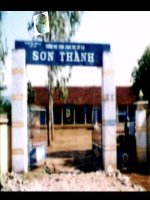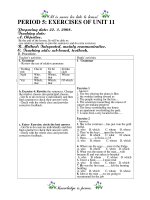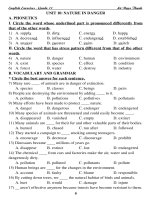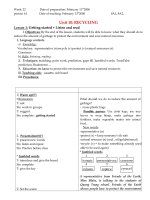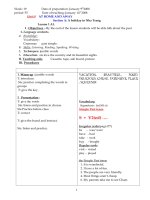- Trang chủ >>
- THPT Quốc Gia >>
- Lý
UNIT 10
Bạn đang xem bản rút gọn của tài liệu. Xem và tải ngay bản đầy đủ của tài liệu tại đây (109.6 KB, 15 trang )
<span class='text_page_counter'>(1)</span>Unit 10:. RECYCLING. Division of lessons 1. Getting started + Listen and read 2. Speak 3. Listen 4. Read 5. Write 6. Language Focus. Unit 10 :Lesson 1 Getting. started Listen and read. I. Objectives: By the end of the lesson students will be able do something to protect the environment and save natural resources II. Language content a.Grammar: none b.Vocabulary: representative (n) recycle (v) protect (v) contact (v) natural resources (n) III Teaching aids: posters, a chart, cassette IV. Techniques: Jumbled words, True/False prediction, Brainstorm… V. Procedures: Teacher ‘s and Ss’ activities. Contents. 1/ Warm up(5’) Asks Ss to think of ways to reduce the Brainstorm amount of garbage they produce. Deliver posters to Ss , dividing them into 4 Ways to reduce groups. the amount of Tell Ss to put the posters on the board garbage after they finish and the team having the most ideas is the winner.. reuse plastic bags Possible answer Use cloth bags, use tree leaves to wrap things, make garbage into fertilizer, make vegetable matter into animal food…. I presents the new words to Ss. Ss repeat then say the meaning. Presentation(10’) New words -representative (n) người đại diện, đại biểu -protect (v) = keep someone/sth safe danger.
<span class='text_page_counter'>(2)</span> -natural resource (n) (coal mines, oil/gold/mineral deposits) Ss repeat and copy -recycle (v) = to make something already used able to be used again) -contact (v) = communicate with someone by telephone or letter … * Jumbled words 1 2 3 tconatc presentativea ceresoru Stick 6 flashcards with jumbled words on the board 4 5 6 cyrecel ralnuta ropttce Ask Ss to rewrite the words in the right order 3. Pratice (20’) Set the scene: A representative from Friends of the Earth, Miss Blake, is talking to the students of Quang Trung school. Friends of the Earth shows people how to protect the environment and save natural resources Put the chart with the statements on the board Ask Ss to work in pairs to decide if the Statements are True or False. Write the Ss’ guesses on the board.. True/False predictions / Marks 1/ Friends of the Earth is an organization to help people make friends with each other 2/ Miss Blake asks the students to remember 3 things: reduce, reuse, recycle. 3/ Reduce means buying the products which are operpacked. 4/ We can not reuse things like envelopes, glass, plastic bottles, old plastic bags. 5/ Miss Blake says that we should use cloth bags and shouldn’t use plastic bags at all. 6/ Recycling means not just throwing things away but trying and finding another use for them. Answer key 1. False … an organization to help people protect the environment and save natural resources 2. True 3. False Reduce means not buying… Ask Ss to open their books, listen to the 4. False we can reuse things … tape while reading the dialogue. 5. True Call on Ss to correct the False statements 6. True * Comprehension questions.
<span class='text_page_counter'>(3)</span> a/ Reduce means not buying product which are overpacked b/ We can reuse things like envelopes, glass, Ss practice the dialogue plastic bottles and old plastic bags Ask Ss answer the question on page 90 c/ Recycle means not just throwing things Ss work in pairs away. Try and find another use for them. Teacher calls some pains to ask and d/ We can look for information on recycle answer the questions things by having a contact with an organization like Friends of the Earth, going to the local library, or asking your family and friends or scientific society. e/ (Possible answer) Miss Blake tells Lan that we shouldn’t use plastic bags at all because plastic bags are difficult to be destroyed, so the amount of garbage increases. T corrects 4. Consolidation (5’) Discusstion Write the topic on the board “How to protect our envirnment ?” Ask Ss to express their opinions/ideas Write their ideas on the board T corrects and has Ss copy 5. Homework (5’) -Do exercises in workbook -Learn by heart new words -Prepare next lesson : Lesson 2 Speak Remarks: ......................................................................................................................................... ......................................................................................................................................... ......................................................................................................................................... ..........................................................................................................................................
<span class='text_page_counter'>(4)</span> Unit 10:. Lesson 2 Speak. I. Objectives This lesson helps Ss practice in giving and responding to instructions II. Language contents 1. Grammar: none 2. Vocabulary: fertilize (v) fabric (n) compost (n) leather (n) III. Teaching aids: picture (copied from Textbook,sub- board IV. Techniques: Kim’s game, Bingo, Dictation List, Mapped dialogue V. Procedures Teacher’s and Ss’ activities. Contents. 1. Warm up (5’) Show the picture to the Ss and ask them to Memory game (Kim’s game) observe it carefully, let them look at the picture for about 20’’ then put it away Ask Ss to go to the board and write as many words showing things in the picture Possible answer as possible Used paper, old newspapers, books, cardboard, boxes, bottles, glasses, jars, plastic bags, food cans, drinking tins, vegetable matter, clothes, shoes, T corrects schoolbags,… 2. Pre-speaking (10’) Elicit words -fertilizer (n) (farmers often use this thing to T presents some new words make their plants or trees grow well. What T can explain some words in English or is it) fertilize (v) use the picture -Compost (n) phaân troän Ss say the meaning (What do you call the fertilizer made from Ss repeat and copy spoiled food, leaves, vegetable matter …) -fabric (n) (realia: clothes) (What are these clothes made of ?) -leather (n) (our shoes, sandals are often made of …? Get Ss to brainstorm a list of about 10 * Bingo words fertilize, compost, leather, fabric, plastic, glass, Ask Ss to choose 4 words and copy into metal, paper, cardboard, tin … their papers. Call out the words until a/student (s) has/have ticked all of their words and shout “Bingo” and they win. 3. While-speaking (20’).
<span class='text_page_counter'>(5)</span> Tell Ss they are going to listen to the words for items and put them into the right groups. Draw the table on the board and ask Ss to copy it. Tell Ss to listen to the words and put them in the right columns Model some words. Dictation List Answer key Group Paper. Items used paper (old newspaper, books, cardboard boxes) Glass bottles, glasses, jars Plastic plastic bags, plastic bottles Metal food cans, drinking tins Fabric Clothes (cloth bags, material) Leather Shoes, sandals, school bags Vegetable Fruit peels, (vegetables, matter rotten fruit. Put the mapped dialogue chart on the Mapped dialogue/Marks board Which group (do Elicit the exchanges from Ss Have some pairs practice each exchange clothes) belong to? Put them in What can we do (fabric) before going on to another exchange. We can recycle After finishing the dialogue, ask a good with (those clothes)? them and make pain to demonstrate the whole dialogue. them into paper Ss work in pairs, replacing the information or shopping (in brackets with the words in dictation Are/Is (fruit vegetable bags list. matter)? That’s right T corrects What will we do with (it) We make (it into compost and fertilize our field ) 4. Post-speaking (5’) T asks Ss to put these words in the correct Put these words into the correct groups groups Aluminium cans –apple pie- butter-cakescar tires-old clothes-dictionary-waste paperglassware-horror story-jam-magazinesnewspapers-plastic toys-picture books-porkvegetable matter-textbook-novels > Things to eat : ...................................... >Things to read :......................................... >Things to recycle : .................................. 5. Homework(5’) -Do exercise in the workbook..
<span class='text_page_counter'>(6)</span> -Practice the dial with your partners replacing the information. -Prepare : lesson 3 Listen Remarks: ......................................................................................................................................... ......................................................................................................................................... ......................................................................................................................................... .......................................................................................................................................... Unit 10:. Lesson 3 Listen. I. Objectives This lesson helps Ss practice listening for specific information about making compost. II. Language contents 1. Grammar: none 2. Vocabulary: tissue (n) pick (n) shovel (n) shade (n) grain(n) compost heap(n) moisture (n) condensation (n) pile(n) III. Teaching aids: stereo IV. Techniques: Rub out and remember V. Procedures Teacher and Ss’ activities. Contents. Warm up (5’) T asks Ss some questions about .What can we do with “vegetable matter” ? compost .Do you know how to make compost ? T corrects .Should you water the compost ? -Elicit words T presents some new words Pre-listening (10’) T can explain some words in English tissue (n) or use the picture pick (n) Ss say the meaning shovel (n) Ss repeat and copy shade (n) grain(n) compost heap(n) moisture (n) condensation (n) pile(n) *** Rub out and remember T checks voc While- listening (20’) Tell Ss they are going to listen to an expert who gives the instructions to make compost..
<span class='text_page_counter'>(7)</span> Ask Ss to open their books and read the multiple choice question on page 91. Check if Ss understand the questions Play the tape 2 or 3 times. Ss listen Answer key and do the exercise. a. A b. B c. A d. B Ss answer and T corrects. 4. Post- listening (5’) True or false statements Ss choose true or false a/ The expert explains how to start a compost heap T asks Ss to correct the false b/We can use meat or grain products to make compost sentences c/ We should find a place in our garden that gets a few hours of sunlight each day d/ We shouldn’t use picks to turn the compost e/ If the weather is very wet , we should cover the heap with a sheet of strong plastic Homework (5’) -Do exercise in the workbook. -Learn new words -Prepare: lesson 3 Read. Remarks: .......................................................................................................................................... .......................................................................................................................................... ........................................................................................................................................... Unit 10 : Lesson. 4 Read. I. Objectives By the end of the lesson, S s will be able to read for details about how things are recycled. II. Language contents 1. Grammar: Passive form in the Present Simple tense. 2. Vocabulary: tire(n), pipe (n), deposite (n), refill (v), melt (v) III. Teaching aids: wordsquare chart, photocopied pictures (p.95), drawing….
<span class='text_page_counter'>(8)</span> IV. Techniques: rub out and remember, Grid,… V. Procedures: Teacher and SS’ activities Put the wordsquare chart on the board Tell Ss the topic is about the environment and there are 14 hidden words. Divide the class into 4 groups. Ask Ss to write their answer on a piece of paper and hand in when they finish. Tell Ss the group with the most right words is the winner. Contents Warm up (5’) Revision : Wordsquare. E N V I R O N M E N T N B C G A R B A G E R V E D R D O P P U R E E J U E Y I L A R S C L U S E D P A P E R Y O S T N O T S E D E C P R O T E C T R U U L E A B R C A I B C S E R E C E E N C A E E K D E E E F G H G I J L Answer key Environment, garbage, pure, used paper, protect. Envelope, dust, green tree, can, plastic T presents new words paper bag, reduce, reuse, recycle. Ss repeat and say meaning Pre-reading (10’) Ss copy Pre-teach Vocabulary -tire (n) -pipe (n) -deposit (n) Ss play the game to check Vocabulary -refill (v): to fill something empty again -melt freeze Draw the grid on the board and have Ss Rub out and Remember Copy it. While-reading (20’) Ask Ss to open their books and read the Grid (Read 2) text Answer: Ask Ss to work in pairs to make a list of Used things Recycling Facts recycling facts mentioned in the text are recycled to make call on some Ss to write the information Car tires pipes and floor recoverings in the grid on the board. Milk bottles are cleaned and refilled (with milk) Glass is broken up, melted and made into new glassware are brought back for Ask Ss to work individually to wnswer Drink cans.
<span class='text_page_counter'>(9)</span> the questions on page 93. Let Ss compare their answer with their partners (pairwork) Call on some Ss to answer. recycling Household and is made into compost garden waste Comprehension questions (Read 1) ->Answer key a/ People cleaned and refilled empty milk T corrects bottles. b/ The glass is broken up, melted and made Elicit the madel sentences froms Ss the into new glassware have Ss repeat. c/ The Oregon government made a new law Ss listen carefully and notice the that there must be a deposit on drink cans. The grammar point. deposit is returned when people bring the cans back for recycling. After Ss copy in their notebooks. e/ If we have a recycling story to share, we can call or fax the magazine at 5 265 456 Model sentence: Passive Voice/Form Car are recycled To make pipes and tires floor coverings Glass is recycled into new glassware S be past part Concept checking. T gives an example Ss retell the story with Passive Form. They can tell main details. + Form: Passive Form in the Present Simple Subject+ am/is/are + Past Participle + Use: it is used when the subject is affected by the action of the verb (Vietnamese can be used for weaker students). Change an active sentence to a passive one Active S+ V + O Passive Eg: I. S + be + Vpp + by O love my parents. My parents sre loved by me Post-reading (8’) Homework (2’) -Learn by heart Voc + Passive Form -Do exercise in workbook -Prepare: Lesson 5 write Remarks:.
<span class='text_page_counter'>(10)</span> ......................................................................................................................................... ......................................................................................................................................... ......................................................................................................................................... .......................................................................................................................................... Unit 10 : Lesson 5. Write. I. Objectives Students will be able to write a set of instructions on how to recycle used things using the sequencing. II. Language contents 1. Grammar: none 2. Vocabulary: soak (v), mash (v), wire mesh (n) , bucket (n) III. Techniques: Lucky numbers, slap the board, ordering, prediction. IV. Teaching aids: drawing, mine, photocopied pictures (p.94) V. Procedures Teacher and Ss’ activities Write 9 numbers on the board, from 1 to 9 Tell Ss each numbers is for a question but 3 of them are lucky numbers. If Ss choose a lucky number, they do not have to answer any question but they get 2 points and they can choose another numbers. Divide the class into 2 teams. I remarks and give marks. I presents some new words Ss repeat and say the meaning. Set the scene: Tell Ss they are going to read a text about how to recycle used paper. Put the verbs on the board randomly in a flow chart. Contents Warm up/Marks (10’) Lucky Numbers 1. Lucky Numbers 2. Say this sentence into the passive “People speak English everywhere” 3. Say this sentence in the active “Cartoons are liked by most children” 4. Lucky number 5. Lucky number 6. Passive: “We do not use things carefully” 7. Active: “Are candies liked by the children ?” 8. Passive: “Mr Han teaches Maths” 9. Passive:“Vegetarians do not eat meat” Pre-writing (5’) -Pre-teach Vocabulary -soak (v): put sth in liquid for a time so that it becomes completely wet -mash (v) đánh nhừ, nghiền nát -wire mesh (n) lưới thép -bucket (n) thuøng, xoâ Slap the board While-writing (20’) Ordering prediction (write 1) soak. dry. pull out. mix.
<span class='text_page_counter'>(11)</span> Ask Ss to work in groups to guess the order press mash of the actions. Call on about 2 pairs to write their answer 1_______ 2_______ 3________ on the board. 4_______ 5_______ 6________ Explain the process of recycling T corrects Answer key Ask Ss to open their books, read the text on 1. soak 2. mash page 93 and fill in the verbs. 4. pull out 5. press T corrects and Ss copy the exercise in their Write 2 notebooks. T asks Ss to close their books. Write the sequencing on the board and have Ss practise speaking first. Call on Ss to say the sentences from memory First, __________ Then, _________ Next, _________ After that, _____ Finally, _______ Ss write the text in brief using the sequencing Ss work in group T corrects Stick the photocopied pictures on the board randomly (caûm tính, tuøy yù) Ask Ss to listen and work in groups to rearrange the pictures according to the instructions on how to prepare the tealeaves Ss answer T corrects. 3. mix 6. dry. Answer key 1. use 2. mix 3. place 4. press 5. wrap 6. wait 7. dry Recall ->Answer key First, soak old newspaper in a bucket overnight. Then, mash the paper by a wooden spoon. Next, mix the mashed paper with water. After that, use a wire mesh to pull the mixture out, put it on the cloth and press it down firmly (maïnh, chaët) Finally, take the mesh out of the cloth and dry it in the sun.. Post writing (8’) Ordering Pictures a. First take the used tea leaves from the tea pot b. Next scatter the tealeaves on a tray c. Then dry the leaves in the sun d. Finally, put the dry leaves in a pot for future use Homework (2’) -Write the instructions on how to make a thing you have ever made using the sequencing -Do exercise in workbook -Prepare lesson 6 Language Focus.
<span class='text_page_counter'>(12)</span> Remarks: .......................................................................................................................................... .......................................................................................................................................... .......................................................................................................................................... ........................................................................................................................................... Unit 10 : Lesson 6. LANGUAGE FOCUS. I. Objectives Students will be able to form the Passive in Future simple and the structures with Adjectives II. Language contents Vocabulary:none Grammar : Passive in Future simple / Passive in Present Simple It + be + Adj + To- Inf / that clause III. Techniques: Ordering pictures , question game, Interview, gap fill, matching IV. Teaching aids: cardboards, posters, handouts V. Procedures :. Teacher’s and Ss’ activities Call on Ss to go to the board and give him/her a job name. Ask the rest of the class to guess the job by asking yes. No question or Pelmanism T corrects and gives marks Ask Ss to read the instructions and look at the picture on page 95 Ask Ss to put the pictures in the correct order according to the instructions. After ask Ss to rewrite the sentences (L.F1) in the Passive form. Ss write on the board. T corrects. Contents Warm up/Marks (5’) -Do you get a big salary ? -Do you wear uniform ? … Pelmanism 1. take a/ eaten 2. bring b/ taken 3. eat c/ brought 4. … d/ … While (14’) *Ordering pictures (Language Focus 1) Answer key a. 1 b. 4 c. 3 d. 5 e. 2 f. 6 Rewriting Answer key b/ Then the glass/ it is washed with a detergent liquid c/ The grass pieces are dried completely.
<span class='text_page_counter'>(13)</span> d/ They are mixed with certain specific chemicals. e/ The mixture is melted until it becomes a liquid. f/ A long pipe is used. It is dipped Set the scene: (nhuùng) into the liquid, then the liquid is A famous inventor, Dr Kim, is going to build blown into intended shapes. a time machine. One of his assistant, Hai, is * Pre-teach structures (L. Focus 2) asking him questions about the invention. He wants to know when Dr Kim will start the project. How can he say the sentence in the Passive ? (I can use Vietnamese for weaker student). T asks Ss to complete the sentences using the Passive in Future Simple. Ss complete the sentences. T corrects. Model sentences When will the project be started? will S be past participle Concept checking Use: Passive Form in the Future Simple. Form: will/shall + be + past participle + Fill in the gaps using the Passive 1. It______to the public when it is finish (show) 2. ____it____by the end of the year? (build) 3. It_____before Tet (finish) 4. _____it______by you ? (make) Answer key 1.will be showed/shown 2.will…be built…? 3.will be finished 4.will…be T prepares 2 separate large cardboards, one made..? Interview for Dr Kim, one for Hai Ask Ss to play role of Hai to interview Mr Hai Dr Kim Kim 1.When/will/the 1.very soon Teacher (Dr Kim) project/start/ ? Student (Hai) 2.Mary people 2.yes/It/show/to T can deliver hand-outs (same content as 2 /want / see/time the cardboards) to the whole class and ask them machine/ public/when/it/fini to do pair work 3.will /it /build / by sh/ T corrects the end / year/ ?.
<span class='text_page_counter'>(14)</span> 4.will/it/make/by you? 5.Let’s begin tomorrow. 3.I’m afraid not / but/ It/ finish/ before Tet/ 4.No/ I /need you/ build it when can you start?. Set the scene: Ba gives Nam a lot of directions at a time so Nam find it difficult to follow Ba’s * Pre-teach structures (L.Focus 3)(8’) directions. What does he say to Nam? T explain the model sentences Model sentences Ss copy It’s difficult to follow your directions Ask Ss to open their books and complete the It’s + be + Adjective + to Infinitive dialogues on page 96 Gap fill Work in pair Call some pairs to demonstrate the dial Answer key a/ difficult to follow b/ easy to understand c/ hard to believe T corrects d/ dangerous to wait e/ important to wait Set the scene: Nam passed the English exam * Language Focus 4 and his grandparents are delighted at it. What did they write to him ? T presents model sentence and explains Model sentences Ss copy the form We are delighted that you passed the T asks Ss to read the letter on page 97 and English exam. match the words S + be + Adj + that/Noun clause Call on some Ss to go the board to draw the lines. Matching Ss copy the Voc. 1. relieved (a) mừng 2. congratulation (n) 3. look forward to (v) 4. confirm (v) Ask Ss to work in pairs to complete the letter Post (8’) using the words in the box Ss answer T corrects Answer key (1) was happy (2) am relieved. a.. xin. chuùc. b. trông chờ c. xaùc nhaän laïi d. nheï nhoõm. (3) is afraid (4) Are you sure.
<span class='text_page_counter'>(15)</span> (5) am certain. Homework (2’) -Rewrite the letter beginning with ” Nam’s grandparents are delighted that he …” -Do the exercises in the workbook -Prepare: Unit 11. Lesson 1 Remarks: ........................................................................................................................................... ........................................................................................................................................... ........................................................................................................................................... ............................................................................................................................................
<span class='text_page_counter'>(16)</span>
